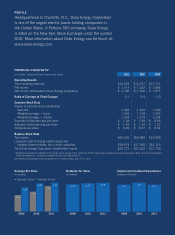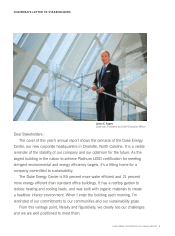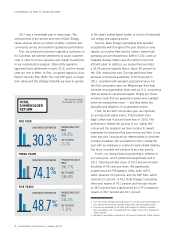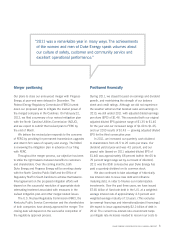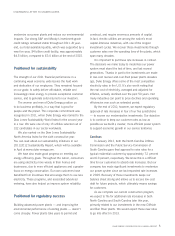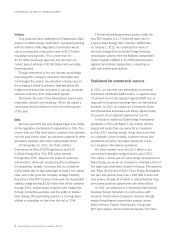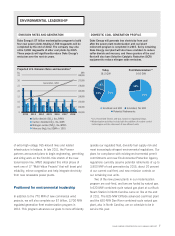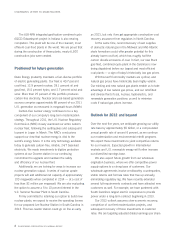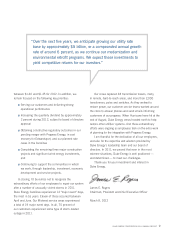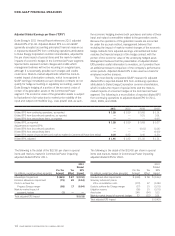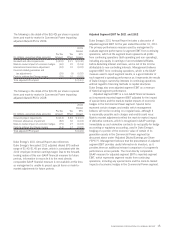Duke Energy 2011 Annual Report Download - page 7
Download and view the complete annual report
Please find page 7 of the 2011 Duke Energy annual report below. You can navigate through the pages in the report by either clicking on the pages listed below, or by using the keyword search tool below to find specific information within the annual report.modernize our power plants and reduce our environmental
impacts. Our strong S&P and Moody’s investment-grade
credit ratings remained stable throughout 2011. At year-
end, our total available liquidity, which was supported by a
new five-year, $4 billion credit facility, was approximately
$4.5 billion, compared to $3.4 billion at the end of 2010.
Positioned for sustainability
The strength of our 2011 financial performance in a
continuing weak economy underscores the hard work
and dedication of our employees. They remained focused
on our goals: to safely deliver affordable, reliable and
increasingly clean energy, to provide exceptional customer
service, and to generate solid returns for our investors.
The women and men of Duke Energy position us
to do business profitably, in a way that is good for
people and the planet. This corporate commitment was
recognized in 2011, when Duke Energy was named to the
Dow Jones Sustainability World Index for the second year
in a row. We were one of only 13 utilities selected out of
102 candidates in our sector worldwide.
We also ranked on the Dow Jones Sustainability
North America Index for the sixth consecutive year.
You can read about our sustainability initiatives in our
2011|2012 Sustainability Report, which will be available
in April at www.duke-energy.com.
We have also made good progress on meeting our
energy efficiency goals. Throughout the nation, consumers
are using electricity more wisely in their homes and
businesses, due to more efficient appliances and a greater
focus on energy conservation. Our own customers have
benefited from incentives that encourage them to use less
electricity. These programs, and associated advanced
metering, have also helped us improve system reliability.
Positioned for regulatory success
Building advanced power plants — and improving the
environmental performance of existing plants — doesn’t
come cheaply. Power plants take years to permit and
construct, and require enormous amounts of capital.
In fact, electric utilities are among the nation’s most
capital-intensive industries, with one of the longest
investment cycles. We recover those investments through
customer rates over the operating lives of the plants, which
span many decades.
It is important to put these rate increases in context.
The decisions we make today to modernize our power
system must stand the test of time, and last several
generations. Thanks in part to the investments we made
in low-cost nuclear and coal-fired power plants decades
ago, Duke Energy offers some of the most competitive
electricity rates in the U.S. It’s also worth noting that
the real cost of electricity, averaged and adjusted for
inflation, actually declined over the past 50 years. Not
many industries can point to price declines and operating
efficiencies over such an extended period.
By the end of 2012, however, we expect regulatory
approval of rate increases in four of our five jurisdictions
— to recover our modernization investments. Our objective
is to continue to keep our customer rates as low as
possible as we build a cleaner, more efficient power system
to support economic growth in our service territories.
Carolinas
In January 2012, both the North Carolina Utilities
Commission and the Public Service Commission of
South Carolina gave final approval to raise rates for a
typical residential customer by approximately 7.2 percent
and 6.0 percent, respectively. We know this is a difficult
time for our customers to absorb rate increases. But our
company has made significant investments to modernize
our power system since we last requested rate increases
in 2009. Recovery of those investments keeps our
balance sheet strong and allows us to access low-cost
debt for future projects, which ultimately means savings
for customers.
As we complete our current construction program,
we expect to file for additional rate increases in both
North Carolina and South Carolina later this year,
primarily related to our investments in the new Cliffside
and Dan River plants. We would expect these new rates
to go into effect in 2013.
CHAIRMAN’S LETTER TO STAKEHOLDERS
DUKE ENERGY CORPORATION 2011 ANNUAL REPORT 5


